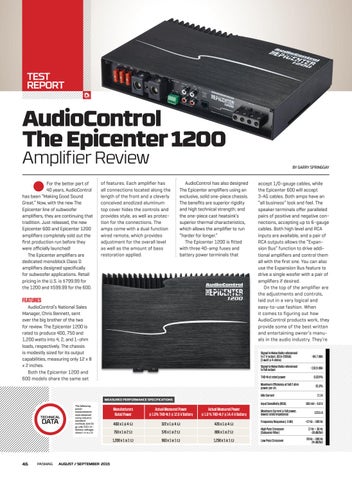TEST REPORT
AudioControl The Epicenter 1200
Amplifier Review For the better part of 40 years, AudioControl has been “Making Good Sound Great.” Now, with the new The Epicenter line of subwoofer amplifiers, they are continuing that tradition. Just released, the new Epicenter 600 and Epicenter 1200 amplifiers completely sold out the first production run before they were officially launched! The Epicenter amplifiers are dedicated monoblock Class D amplifiers designed specifically for subwoofer applications. Retail pricing in the U.S. is $799.99 for the 1200 and $599.99 for the 600.
BY GARRY SPRINGGAY
of features. Each amplifier has all connections located along the length of the front and a cleverly conceived anodized aluminum top cover hides the controls and provides style, as well as protection for the connections. The amps come with a dual function wired remote, which provides adjustment for the overall level as well as the amount of bass restoration applied.
AudioControl has also designed The Epicenter amplifiers using an exclusive, solid one-piece chassis. The benefits are superior rigidity and high technical strength; and the one-piece cast heatsink’s superior thermal characteristics, which allows the amplifier to run “harder for longer.” The Epicenter 1200 is fitted with three 40-amp fuses and battery power terminals that
FEATURES AudioControl’s National Sales Manager, Chris Bennett, sent over the big brother of the two for review. The Epicenter 1200 is rated to produce 400, 750 and 1,200 watts into 4, 2, and 1-ohm loads, respectively. The chassis is modestly sized for its output capabilities, measuring only 12 x 8 x 2 inches. Both the Epicenter 1200 and 600 models share the same set
accept 1/0-gauge cables, while the Epicenter 600 will accept 3-AG cables. Both amps have an “all business” look and feel. The speaker terminals offer paralleled pairs of positive and negative connections, accepting up to 6-gauge cables. Both high level and RCA inputs are available, and a pair of RCA outputs allows the “Expansion Bus” function to drive additional amplifiers and control them all with the first one. You can also use the Expansion Bus feature to drive a single woofer with a pair of amplifiers if desired. On the top of the amplifier are the adjustments and controls, laid out in a very logical and easy-to-use fashion. When it comes to figuring out how AudioControl products work, they provide some of the best written and entertaining owner’s manuals in the audio industry. They’re Signal to Noise Ratio referenced to 2 V output. (CEA-2006A) (1 watt @ 4 ohms)
-84.7 dBA
Signal to Noise Ratio referenced to full output
-110.9 dBA
THD+N at rated power Maximum Efficiency at full 2 ohm power per ch. Idle Current
MEASURED PERFORMANCE SPECIFICATIONS
TECHNICAL
DATA
46
PASMAG
The following power measurements were obtained using industry standard methods. (100 Hz @ 1.0% THD+N Battery voltages shown +/- 0.2 V)
Input Sensitivity (RCA)
Manufacturers Rated Power
Actual Measured Power @ 1.0% THD+N // @ 12.6 V Battery
Actual Measured Power @ 1.0 % THD+N // @ 14.4 V Battery
400 x 1 @ 4 Ω
322 x 1 @ 4 Ω
426 x 1 @ 4 Ω
Maximum Current @ full power, lowest rated impedance Frequency Response (-3 dB)
750 x 1 @ 2 Ω
576 x 1 @ 2 Ω
806 x 1 @ 2 Ω
High Pass Crossover (Subsonic Filter)
1,200 x 1 @ 1 Ω
963 x 1 @ 1 Ω
1,258 x 1 @ 1 Ω
Low Pass Crossover
0.024% 81.8% 2.1 A 160 mV – 6.8 V 123.5 A <17 Hz – 180 Hz 17 Hz – 36 Hz -18 dB/Oct 28 Hz – 180 Hz 24 dB/Oct
AUGUST // SEPTEMBER 2015
AudioControl Epicenter Amp_Aug_Sept_2015 v3 (FP-FPHP-DHPS).indd 1
2015-06-09 2:33 PM
